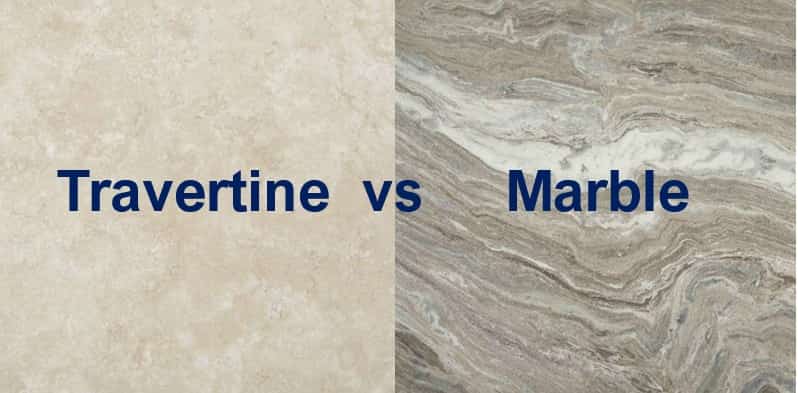Travertine is often mistaken for marble and sometimes it is sold as a type of marble. However, travertine is different from marble, even though they are both a type of limestone.Travertine is a sedimentary stone naturally found near freshwater hot springs. It comes in a wide range of warm earth tones. The formation of travertinestarts with compression of sediments over time into a solid structure. Travertine, unlike other limestones, has many fine holes and channels in it from the ejection of hot water and gases during formation. Typically, these holes are filled when the stone is collected and made into usable tiles. Filling avoids the creation of an overly porous substance that would be a difficult to clean.
Alternatively, marble formswhen the sedimentary stone (limestone or trаvеrtіnе) is subjected to heat and pressure over an extended period of time. The stone undergoes metamorphosis where it recrystallizes and becomes denser and harder. The recrystallization allows the marble to take on a fine, good-looking polish finish during fabrication. The formation of travertine and marble differs, therefore, the final stones are also different. Determining which of the two is better depends on your needs and preferences.
Comparison Between Travertine and Marble Flooring
Use
Bathroom walls, floors, and countertops mostly feature marble tiles. Marble appears crisp and clean while still being elegant and practical. It’s a very hard stone that can withstand everyday use. Its toughness makes it good for high-traffic areas. With the application of a sealant on the tiles at least once a year, you are certain to protect the marble tiles from damage. Travertine tiles, on the other hand, are used indoors for bathroom flooring and kitchens. The tiles can be used to decorate ceilings, walls and countertops. However, they are also useful in outdoor spaces. Travertine is usually rough before it’s polished and honed. The high friction surface of the tiles makes them suitable for outdoor use. For this reason, travertine tiles and pavers are often installed by pools.
Cost
When it comes to the price tag, natural marble costs more than natural travertine. However, you can opt for cultured marble which is cheaper than both natural tiles.Processing marble blocks costs more since the stone is harder yet more fragile. Special treatment is applied at the back of the tile to prevent breakages. All these additional processing costs are transferred to the consumer hence the high consumer price.Moreover, marble tiles require a good initial seal for protection against scratching and staining.
Since travertine is softer, processing the stone is easier and cheaper. Moreover,different types of travertine can be produced after processing. The types include honed, tumbled, chiselled edges, polished and pillowed. Nonetheless, costs also vary depending on the stone quality and the geographical region. Marble and travertine are both heavy and transportation is always cumbersome. Therefore, those who reside close to production areas enjoy cheaper prices than those far from the processing plants.
Aesthetics
Beauty lies in the eyes of the beholder but marble has a reputation of offering the ultimate luxurious look and feel. The veins on marble accentuate its beauty and give it a stunning look. The tiles come in different tones. Some tiles even have multiple tones like the Rain Forest Green tile. On the other hand, travertine tiles have much more colour and finish choices. More often than not, marble only comes in the honed or polished finish.
Durability and maintenance
Chips and scratches are inevitable when it comes to travertine and marble tiles. However, they can be repaired by filling them in. Of the two stone, travertine is the more durable choice. It is more porous and can be used without being sealed hence its outdoor application.Both stones are vulnerable to acidic liquids which tend to etch and stain the surfaces. Nonetheless, marble and travertine can be sealed to protect them against harsh liquid stain like soy source, wine or bathroom cleaning products. Sealed tiles are the best choice or bathroom and kitchen application. Sealing can be done once or twice a year to keep the tiles in good shape. When the stone tiles start absorbing water, it’s a sign that they need to be resealed.
Proper care and maintenance are still important when using stone tiles.Spills must be wiped immediately before they form stains. Due to the vulnerability of marble and travertine, their application is often limited to backsplashes, floors, and walls. The tiles used on countertops need to be sealed and kept away from direct sunlight since resins in some sealant react with sunlight to wash away the colour.
The better choice
Both marble and travertine have their pros and cons. Selection depends on the use, the cost and the feel you seek. Nonetheless, both stones are of top quality hence a choice between the two is still a good choice.
